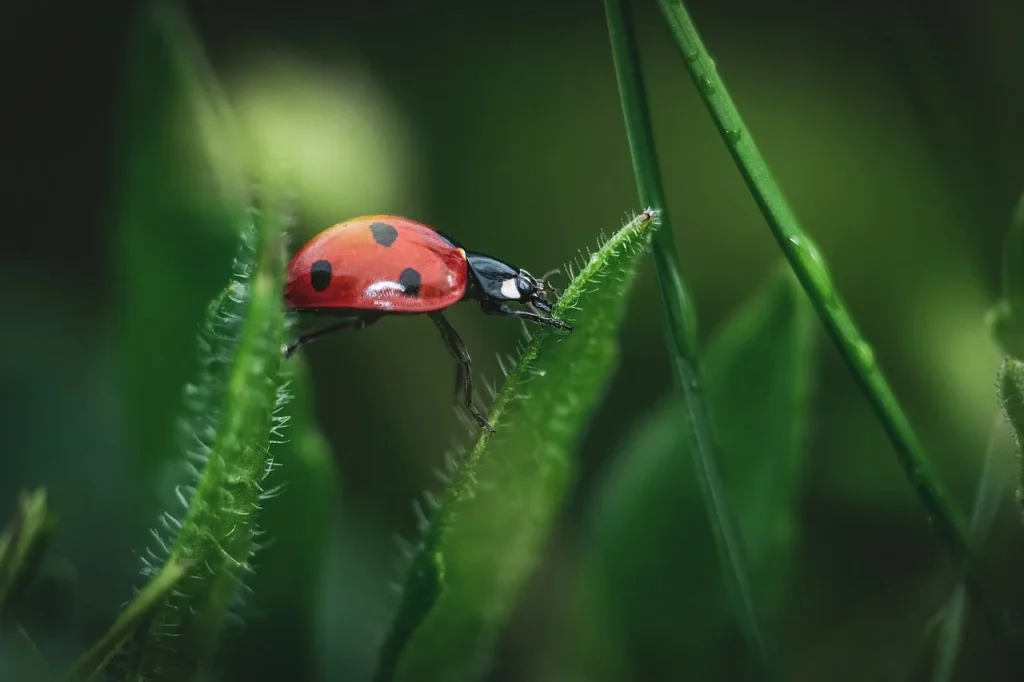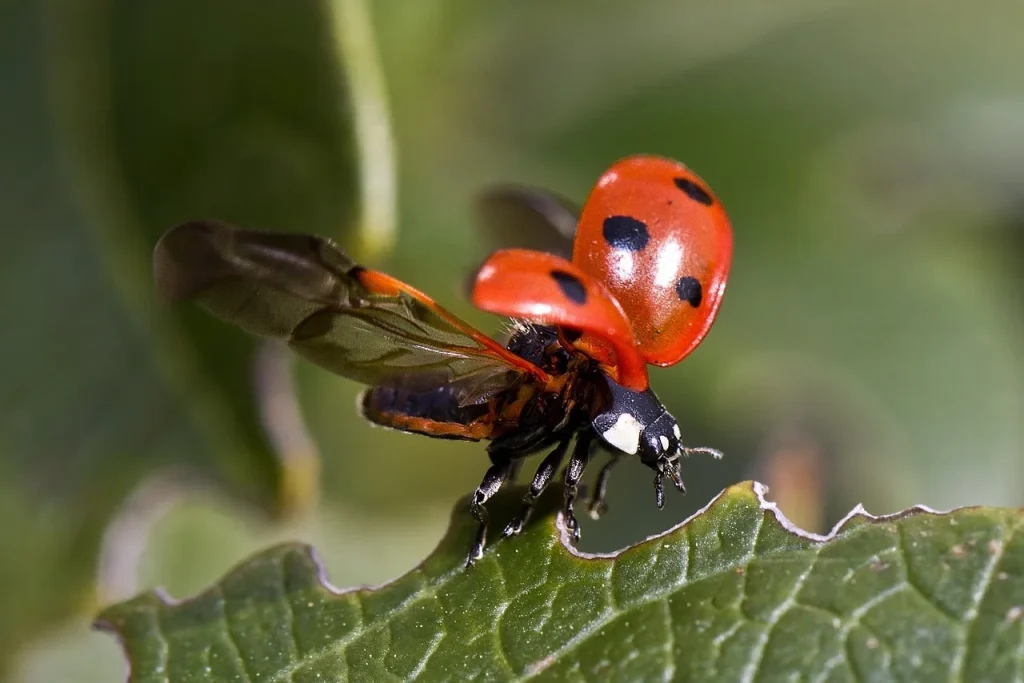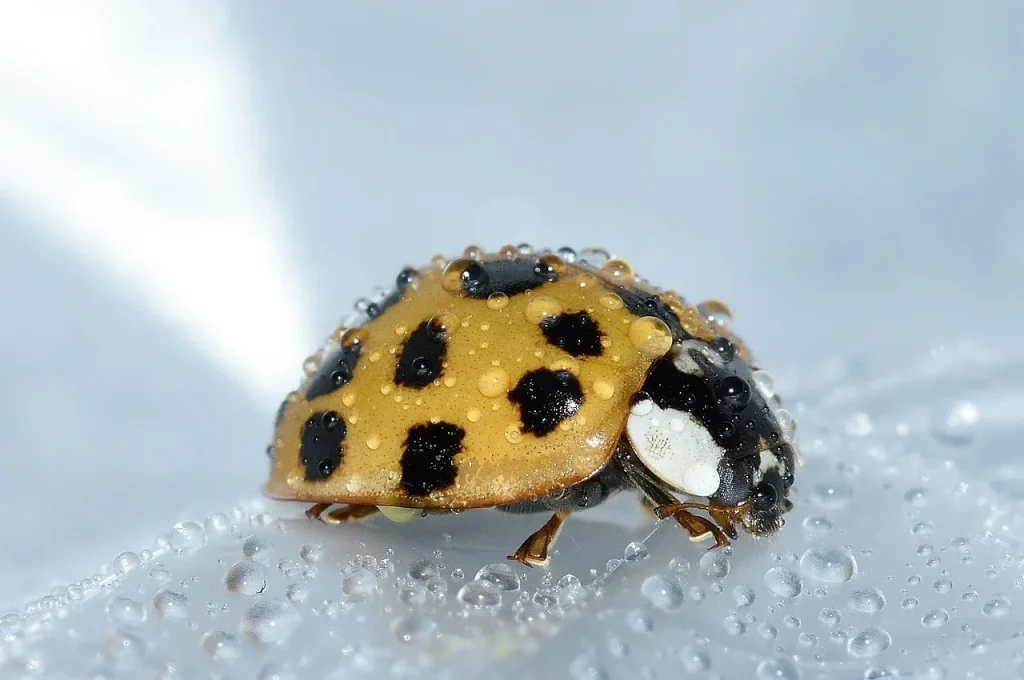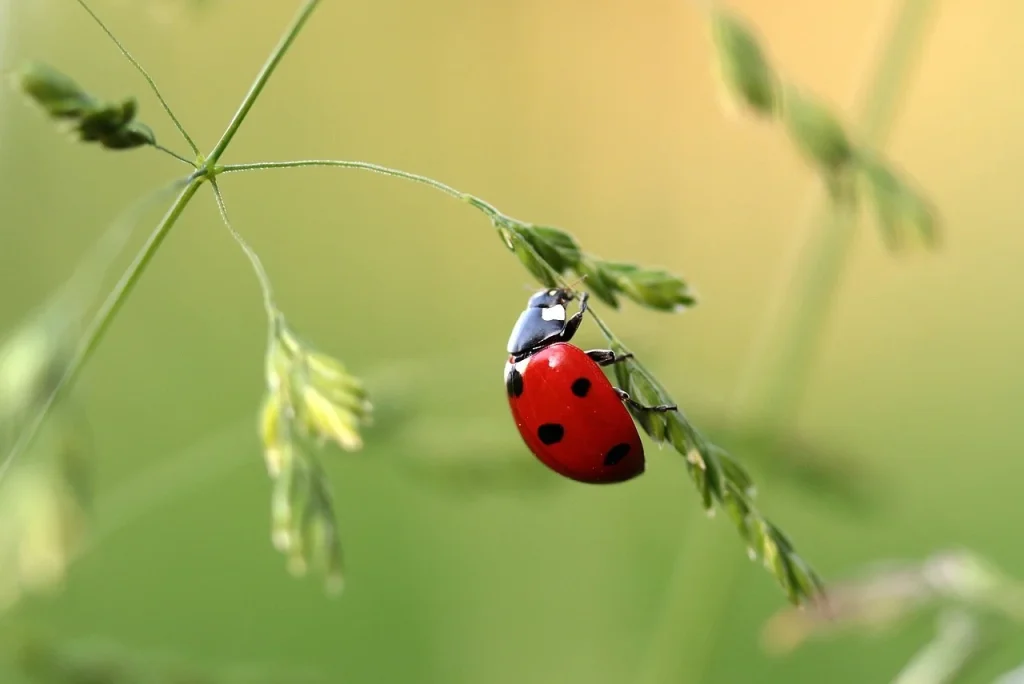Step into the world of ladybugs, where every dot and color has a story to tell. Known scientifically as ‘Coccinellidae’, ladybugs are not only a gardener’s best friend but also fascinating subjects of study due to their behaviors and lifecycle.
This page will share some interesting facts about ladybugs, offering a closer look at how these insects thrive and why they matter to our planet.
Ladybugs all dressed in red, strolling through the flowerbed. If I were tiny just like you, I’d creep among the flowers too!
Maria Fleming
Ladybugs Facts
Welcome to the colorful exploration of ladybugs! Be sure to pay close attention to the facts, as you’ll find a quiz at the end to test you.
- There are over 5,000 different species found across the globe.
- These beetles can eat up to 5,000 aphids in their lifetime, making them powerful pest controllers.
- Some species can live for up to two to three years under optimal conditions.
- In cold climates, they can hibernate in large groups of up to several thousand to stay warm.
- They secrete a yellow fluid from their legs, called reflex bleeding, which has a foul taste and deters predators.
- Their bright colors serve as a warning signal to potential predators about their toxic nature.
- Females can lay up to 1,000 eggs in their lifetime.
- Some species exhibit sexual cannibalism, where the female eats the male after mating.
- They can inflate their bodies to appear larger and more intimidating to predators.
- Not all have spots; some have stripes or are solid in color.
- Their spots fade as they age, providing a clue to their relative age.
- Some can fly as high as 3,600 feet in the air.
- They have a unique way of cleaning themselves by using their legs to wipe their heads and antennae.

- In some cultures, they are seen as a symbol of good luck and prosperity.
- Their larvae, which look very different from adults, are also voracious predators of garden pests.
- Some species have been used in biological control to manage invasive pest populations in agriculture.
- They can drink dew drops to stay hydrated in the morning.
- These beetles can detect the presence of prey from several feet away.
- Some species emit a clicking sound to startle predators.
- Their larvae go through four stages, called instars, before becoming adults.
- They can play dead to fool predators, a behavior known as thanatosis.
- Their wings are hidden under a hard, protective shell called the elytra.
- In Japan, they are considered symbols of love and are often given as gifts.
- Some species can change their spots and color patterns depending on the temperature.
- In the UK, they are known as ladybirds rather than ladybugs.
- They can migrate over long distances to find better living conditions, sometimes traveling hundreds of miles.
- Their name is derived from the Virgin Mary, also called “Our Lady,” which is why they are called ladybirds in some parts of the world.
- They have been known to swarm in large numbers when searching for food or new habitats.

- Some species are bioluminescent, emitting a faint glow in the dark.
- They have a sense of smell located in their antennae, which helps them locate food.
- In the United States, they are also called lady beetles.
- When threatened, they can release a small amount of a toxic substance called alkaloid to deter predators.
- Their larvae resemble tiny alligators with elongated bodies and spiny protrusions.
- They have been used as a natural method of pest control since the early 20th century.
- During the winter, they can enter homes seeking warmth and become a nuisance by congregating in large numbers.
- In some species, the number of spots can help identify the specific species or region they come from.
- They communicate with each other through chemical signals called pheromones.
- Some species exhibit polymorphism, where individuals within the same species have different colors or patterns.

- Their bright colors are a form of aposematism, warning predators of their toxicity.
- In many European countries, they are considered a sign of a good harvest and are called harbingers of good fortune.
- They can produce a foul odor when handled, which acts as a defense mechanism.
- Some species have been found in fossil records dating back to the Jurassic period.
- They can travel at speeds of up to 15 miles per hour when flying.
- Their distinctive appearance has made them a popular motif in art and literature.
- They can survive underwater for short periods by trapping air under their elytra.
- Some species are known to be parasitized by wasps, which lay their eggs inside them.
- They have an internal clock that helps them know when to hibernate or migrate.
- Researchers have studied their flight mechanics to improve micro-air vehicles.
- Some can tolerate extreme temperatures ranging from freezing cold to very hot environments.
- They play a significant role in controlling agricultural pests, saving the industry an estimated billions of dollars each year in pesticide costs.
Ladybugs Myths

Now that we’ve covered some key facts about ladybugs, let’s continue into a different part of their story. In the upcoming section, we’ll separate the truth from the myth, clearing up common misconceptions about these colorful insects.
- Ladybugs Are Always Red With Black Spots
They can be found in various colors and patterns, including yellow, orange, and even all black. The presence of spots, which can vary in number, is not uniform across all species. - Ladybugs Are Only Beneficial for Gardens
While it is true that they are hailed for eating aphids and other harmful pests, their presence can sometimes be problematic. For instance, in large numbers, they are known to invade homes and buildings, causing more nuisance than benefit. - Ladybugs Can Predict the Weather
There is a common belief that they can predict the coming weather. However, this is a myth. Their behavior changes with the weather, such as seeking shelter before a rainstorm, are reactive rather than predictive. - More Spots Mean an Older Ladybug
The number of spots on a ladybug’s back does not indicate its age. Spots are genetically determined and vary by species. They are present from the time they develop into adults and do not increase as they age. - All Ladybugs Are Good for the Environment
While many ladybugs are beneficial, certain species like the invasive Asian lady beetle, are considered pests. These beetles can harm native species, disrupt ecosystems, and become a nuisance in homes.
Ladybugs Quotes

We continue to the quotes section. Feel free to share more quotes in the comments and I will happily add them to the list.
The ladybug wears no disguises. She is just what she advertises. A speckled spectacle of spring, a fashion statement on the wing… A miniature orange kite. A tiny dot-to-dot delight.
J. Patrick Lewis
J. Patrick Lewis, a poet known for his children’s poetry, praises the simple and unmistakable beauty of the ladybug in this joyful ode.
Ladybugs’ wings are a gentle reminder that life is a delicate balancing act between taking flight and staying grounded.
Anonymous
This quote, from an unknown author, reflects on the profound life lesson taught by the effortless grace of ladybugs.
A ladybug symbolizes luck so true, in the skies of azure or gray hue.
Denise Levertov
Denise Levertov, an influential poet, draws a connection between the vivid appearance of ladybugs and the universal symbolism of good luck they carry.
Let ladybugs land on your hand for luck, but never capture their delicate form in a cup.
Kathryn Lasky
Kathryn Lasky, a prolific children’s writer, offers advice on appreciating the beauty of ladybugs without harming them, emphasizing gentle interaction with nature.
When a ladybug lands on you, make a wish, say a prayer, it might come true.
Willow Sidhe
Willow Sidhe, a nature enthusiast and writer, reflects the folklore surrounding ladybugs as bearers of good fortune and the magical moments they bring.
Ladybugs FAQ

We are getting closer to the quiz, but before that it’s the FAQ section. Read carefully these questions if you want to ace the upcoming trivia.
- Are ladybugs poisonous?
No, they are not poisonous to humans or pets. In fact, they are quite harmless and beneficial in gardens as they feed on pests like aphids. - Can ladybugs fly?
Yes, they can fly. They have two sets of wings, and the bright colored ones we usually see are protective covers. Underneath are their delicate flying wings, which they skillfully use to move between plants. - Will ladybugs eat spider mites?
Absolutely! They are natural predators of several garden pests, including spider mites. They help control these pest populations, making them great allies for gardeners. - Why are ladybugs called ladybugs?
The name “ladybug” was coined in Europe during the Middle Ages. It is believed to be derived from the Virgin Mary, often referred to as “Our Lady.” Farmers who prayed to the Virgin Mary for help against pests saw these beetles as a miraculous answer, hence “lady’s bugs.” - Are ladybugs good luck?
Yes, in many cultures, they are considered a symbol of good luck. Seeing one is thought to bring good fortune, and in some places, it’s believed that if a ladybug lands on you, your wish will come true!
Ladybugs Trivia

Welcome to the Ultimate Ladybug Quiz! Get ready to test your knowledge, and remember, if you don’t score a bug’s whisker, you might just turn into a ladybug’s favorite snack—aphids!
Conclusion
From their unique ability to hibernate to their appetite for aphids, ladybugs are fascinating creatures. They are a gardener’s best friend, tirelessly working to keep plants free of pests.
Encouraging their presence in your garden isn’t just good for your plants; it’s a way to support biodiversity and a healthy ecosystem right in your backyard. Till next time, stay curious and explore more. Cheers.


